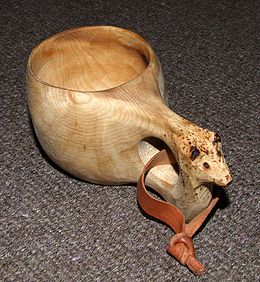
Kuksa
Encyclopedia

Duodji
Duodji is a centuries old Sami handicraft, that dates back to a time when the Sami were far more isolated from the outside world than they are today. Duodji tools and clothing accoutrements served their purpose to be functional and useful, however this does not mean that the Sami handicraft is...
, it is a type of drinking cup made by the Sami people
Sami people
The Sami people, also spelled Sámi, or Saami, are the arctic indigenous people inhabiting Sápmi, which today encompasses parts of far northern Sweden, Norway, Finland, the Kola Peninsula of Russia, and the border area between south and middle Sweden and Norway. The Sámi are Europe’s northernmost...
of northern Scandinavia from carved
Wood carving
Wood carving is a form of working wood by means of a cutting tool in one hand or a chisel by two hands or with one hand on a chisel and one hand on a mallet, resulting in a wooden figure or figurine, or in the sculptural ornamentation of a wooden object...
birch burl
Burl
A burl or bur or burr is a tree growth in which the grain has grown in a deformed manner. It is commonly found in the form of a rounded outgrowth on a tree trunk or branch that is filled with small knots from dormant buds.A burl results from a tree undergoing some form of stress. It may be caused...
.
Creating
The burl is contoured to a rough shape, carefully dried to prevent the wood from cracking, then formed in accordance with the local traditions. Originally guski were widely used in Arctic areas as a personal drinking cup; a well-made guksi would last a lifetime.Modern guksis
Today, a traditional guksi is difficult to find outside northern Scandinavia, partly because burls are seldom harvested in modern mechanized forestry. With the introduction of glass, ceramic and metal drinkingware, the skill of making such duodjiDuodji
Duodji is a centuries old Sami handicraft, that dates back to a time when the Sami were far more isolated from the outside world than they are today. Duodji tools and clothing accoutrements served their purpose to be functional and useful, however this does not mean that the Sami handicraft is...
artwork has become a pastime skill rather than the essential one as it was in the past.
The kuksa as a duodji artwork, has also been a target of cultural appropriation
Cultural appropriation
Cultural appropriation is the adoption of some specific elements of one culture by a different cultural group. It describes acculturation or assimilation, but can imply a negative view towards acculturation from a minority culture by a dominant culture. It can include the introduction of forms of...
as non-Sami artists replicate the work as a souvenir item.

